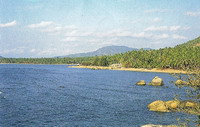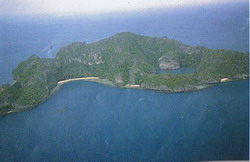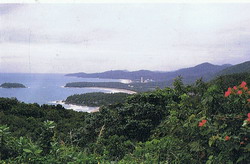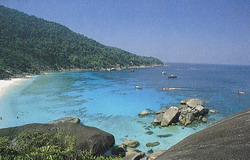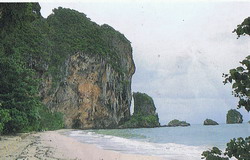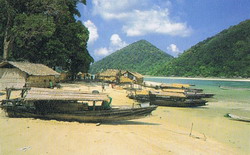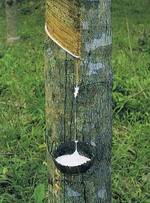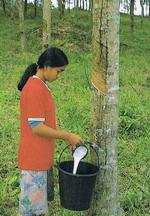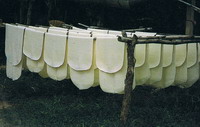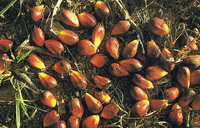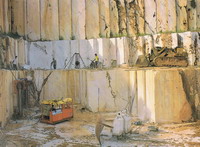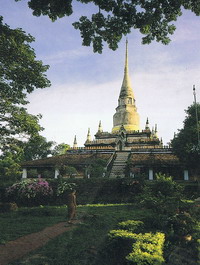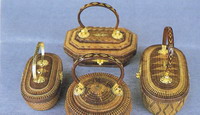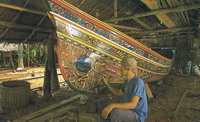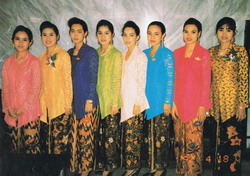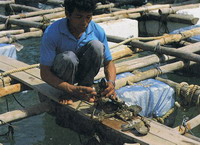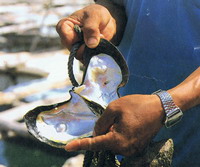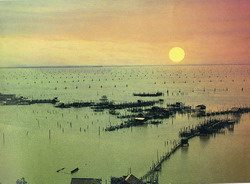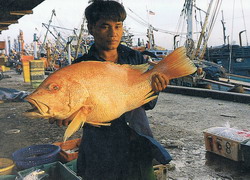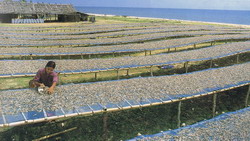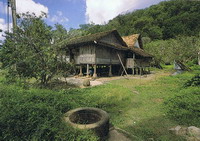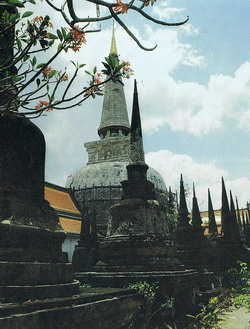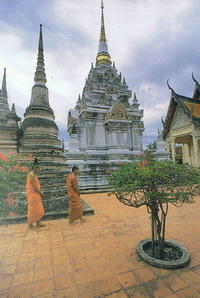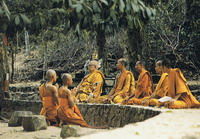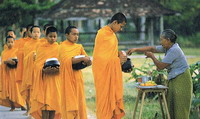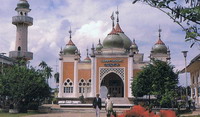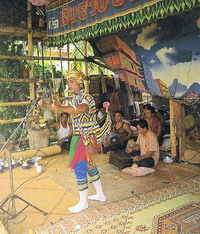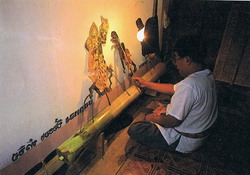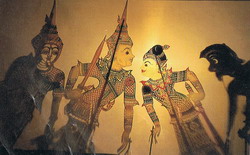
Search
 Custom Search
Custom Search
Cultural Landscape of the Southern Region of ThailandGeographical Setting
Thailand's southern region comprises 14 provinces ; Chumphon, Ranong, Phang-ngaa, Phuket, Surat Thani, Nakhon Si Thammarat, Trang, Phatthalung, Songkhla, Satun, Yala, Pattani and Narathiwat. The land area is 70,189 square kilometers of 13.66 % of the total land area in the country. Geographically speaking, the southern region is a peninsula situated between the Gulf of Thailand on the east and the Andaman Sea on the west. There are several mountain ranges which run paralel to the peninsula, for example the Phuket Range, Nakhon Si Thammarat Range, and San Kalakhiri Range. Both sides of these mountain ranges are coastal flats. the eastern flats used to be a shallow sea filled with alluviums from major rivers such as the Tapi, Chumphon, Pak Phanang, Pattani, and Ko-lok Rivers. The western flats are rugged with no major river except for the Kra River in Ranong. Examples of well-known islands off the western coast are Phuket Island, Tarutao Island, and Lipeh Island.
Due to its peninsular shape, the southern region is under the influence of two monsoon seasons: the wet southwest monsoon starts around May-June and ends in October, and the drier northeast monsoon season starts between October-November and lasts until February,. Both monsoons have a direct influence on the precipitations, humidity, evaporation and temperature of the region including its environment and ecological system. There is no harsh distinction between seasons. The non-deciduous forests are lush and green all year round; and agriculture is possible throughout the year due to abundant rain and fertile soils. As a result, the southern region is very productive. Southerners do not have to leave their home region in search for alternative economic means in the same way as their counterparts in the other regions. Ethnic Group and Populations
The population of the southern region is 8 million or 12.6% of the total population in Thailand. The majority are Buddhist and Muslims. Population density is relatively low. Historically, this region has been sparsely occupies by hunting-gathering "the cave people" and "sea people" the cave people are ancestors of the Negritos (Semang or Sakai) and the predecessors of sea people (Orang Laut, or Proto-Malay, or Sea Gypsies) whose habitats are coastal shores and island caves. It is believed that the southerners are the product of intermarriages between Orang Laut and the Sermang or Sakai, and intermarriages between Orang Laut and the Thias from the central region.
The peninsular south serves as a link between the Indian Ocean and the South China Sea. Therefore, it became a route, a migration path, and a rest stop for missionaries and traders from many countries especially India, China, Middle Eastern, and European countries. These foreigners, particularly the Chinese, came to reside in the southern region, intermingled and intermarried with the locals. Settlements and Communities Coastal settlements and porttowns began to flourish along both sedes of the peninsula, especially on the eastern strip where fertile soils and abundant water facilitate agriculture. Some of the settlements spread out and became signifacant cultural centers such as the "Sri Vijaya" cultural center around Baan Don Bay in Surat Thani and "Tambharalinga" cultural center around Song Khla Lake. These centers were based economically on rice agriculture and the extraction of coastal resources. On the western strip, settlements emerged after a mining industry was developed by the Chinese during the Rattanakosin period. The settlements in Takuapa, Phang-nga, Phuket, and Trang have distinctive Chinese cultural features.
The core of the southern peninsula is not suitable for settlement due to the rugged mountainous landscape.
Cultural Features Material Culture : Housing, Clothing, Food, Medicine and Economic Culture. Housing Culture
House forms vary according to landscape and geographical setting. It is customary to build a house "by the landing, by the paddy field, by the temple", which means to build a house near a water source for the convenience of obtaining water supply; near a canal, river, or sea for the convenience of transporting; near a paddy field for the convenience of engaging in agricultural activities; and near the temple for the convenience of making merit.
Besides the custom of selecting homesites, southernners' uderstanding of the climate and seasonal change has become traditional wisdom in vernacular architecture. For example, southerners placed their houseposts up on stone or wood supports instead or burying them. This is to facilitate moving a housing, prevent wood corrosion caused by high humidity, and prevent ants, termites, or reptiles from crawling up into the house when fleeing a heavy rain or a flood. It is a taboo to build a house "against the sun path" and against the monsoon wind, since the scorching sun will make the house hot for the entire day, and the monsoon storm may blow away the roof or danger the house.
House doors and windows are usually low and narrow. They are designed to open ineard or open by sliding to prevent the wind from banging when opening or shutting. The sloping roof is designed to withstand the wind and to drain rainwater. The lower part of the roof is extended to shield the house from the sun and rain. The vents are located between the roof and the upper wall-line and between the house floor to and the outer porch floor allow the flowing of the breeze. Houses are built with local raw materials. Traditional wisdom recognizes the strengths and weaknesses of particular types of wood. For instance, a certain kind of wood is used only house posts and not for other horizonal structures because the bud areas are particularly fragile.
A house consists of several such as a bedroom for the for the head of the family and a common room which is used as common bedroom, living, or guest's room. Kitchen and rice storage are in a separate quarters. Certain beliefs dictate house patterns; for example, double-tiered houses are not popular because of the belief that they are inauspicious and inappropriate to sit, sleep, stand in, or walk or a higher level than one's elders. Hinges are built above the kitchen hearth to store dry food and to prevent it from mold, ants, and other insects. The outside porch is used as temporary storage and drying area (for clothes as well as for fish, vegetables, and fruits). The Muslims prefer connecting house due to their large extended families. They do not decorate their houses with human or animal patterns to religious prohibitions, so the decorative patterns are of geometrical, floral, and callingraphies.
Southerners have also adopted foreign architectural styles and materials; for example, building double-tiered Chinese style and Chino-Portuguese style houses with a concrete and front porch, and using European glass windows and doors. Clothing Culture Due to its tropical location, days and nights are equally long (12 hours) throughout the year and there is not much seasonal distinction in the southern region. Southerners' clothes are thus simple and do not vary seasonally. Clothes patterns and styles are similar to those of Malaysia and Indonesia. Until about 60 years ago every household would weave its own cloth since women were considered desirable if they possed weaving and houseworking skills. Batik is another popular form of craft in the southern region. The drawback of cloth weaving in the southern region is that southerner do not have their own raw meterials, so income is derived only from the labor and skill of the weavers. Food Culture Southerners prefer spicy food to enhance their appetite and freshen their system. They also consume various kinds of vegetables with their meals. Turmeric is a popular ingredient in curries and soups since it energizes as well as lessens the smell in certain foods. In addition, it is believed to thwart poisons or toxins. Turmeric-dyed sticky rice is another popular food.
Southerners preserve and store food for periods of food shortage during the rainy season and the very dry season. preserved foods include salted fish, pickled fish, salted crabs, salted shrimp, etc. Common food preservation methods are sun drying, roasting, stewing, smoking, salting, and sugar coating. In the dry season the weather is very hot, southerners generally eat sweets at lunch and dinner times to energize themselves. The main ingredients in these desserts and sweets are flour, sugar, and coconut.
Slutherners do not normally slaughter working animals such as cattle and buffalo except for a big feast. They raise pigs for sale and raise chickens and ducks for eggs. Most of the protein food is derived from shrimp, shellfish, crabs, and fish; so subsistence fishing is a signifacant economic means which also engenders the crafting of fishing gears and other equipment. Southerners subsist on three meals a day; rice is their staple while sticky rice is for dessert or used in certain rituals. The whole family usually take their meal together in the kitchen and visiting friends or relatives consider it an honor to be invited to join family meal.
|
Click Here!
|
Not until 50 years age, did southerners employ traditional medicine; they used herbal medicine for common illnesses, and various other methods for chronic and serious illness, and ritualistic magic to ward off bad luck for psychotic illness. Modern medicine gained its popularity about 40 years ago. Traditional medicine derives from natural substances; for example, from different parts of plants (leaf, stamen, flower, fruit, seed, bark, core, sap, root, or pulp); different aprts of animals (hair, skin, antler, horn, fang, bone, gall, meat, and liver); and other substances (potassium nitrate, sulfur, copper sulfate, alumina clay). Traditional doctors use 3 healing methods; knowledge, stratagem, or both. The knowledge method includes the use of traditional wisdom in diagnoses, prescription, medicine, and physical therapy; stratagem includes the use of Dhamma, magic, incantation, psychology, or various other means to raise patient's morale and a hope for recovery.
Practitioners of traditional medicine are reluctant to divulge the secrets of their trade since they are dealing with a major of life and death. The passing on of their knowledge is contingent upon the learner's virtue, intelligence, and patience. Traditional healing has gradually lost its popularity because more attention has been focused on stratagem while knowledge has ceased to develop. Economic Culture In the old days, the means of subsistence for southerners included hunting, gathering, fishing, rice agriculture, pottery, cloth weaving, and craft making. After the southern region became a significant international trade route, trade and exchange flourished. Later, rubber plantations and the mining industry replaced the traditional subsistence economy. Modern fisheries, oil-palm plantation, and other manufacturing industries have also expanded the southerners' economic means.
Abstract Culture Religions Archeological excavations attest to the fact that the southern region is indeed rich in religious traditions. Ancient Buddha images, the statues of Hindu gods, and surviving stone inscriptions indicate that Buddhism and Hinduism had a pervasive influence on the people in the area over a millennium ago. Ancient settlements which gradually developed into cultural centers employed religion as their supporting strength.
Buddhist Thais in the southern gegion now follow the principles of Dhamma. Both Mahayana and Theravada Buddhism have blended harmoniously with Hinduism and traditional spiritual beliefs while Moslem Thais lead their lives under Islamic principles, community traditions, and state regulations. Beliefs and Traditions Southerner's have beliefs and traditions which involve cosmology, the supernatural, and religion. It is believed that the human body consists of 4 basic elements; earth, water, air, and fire; when these 4 elements are in balance, things proceed well but when they are out of balance, an outbreak of illness or chaos may occur. The supernaturals are omnipotent powers which can effect either good or bad luck to human beings and should therefore be revered, given gifts, and offered propritiatory rituals for examle, the spirit of rice, the guardian spirit of bats, and the spirit of the alnd.
indigenous beliefs stem from past experiences and an intimate knowledge of nature; for example, the "auspicious time" for a hunting trip involves knowledge about foraging and resting habits of game animals and knowledge about premonitions of natural disasters such as storms and floods. Taboos also derive from negative or positive past experiences. Some of the taboos include clipping nails at night, building a house above a wooden stumps, stepping over a knife or a sharp weapon, and insulting the sacred or cursing oneself.
Place names are generally derived from geographical or natural resource. Most of the places have names of geographical setting as a root-word and names of prevalent trees or plants as suffix, such as "Boh yang" (Dipterocarpus Pond). Multicultural settlements were found in the southern region for over a millennium, invevitably the local tongue adopted words from Pali, Sanskrit, Tamil, Mon, Khmer, Javanese and Malay; and later, Chinese and European.
Southern literature was influenced by ancient Inadian literature; for example, the epic of Ramayana and the various Jatakas, Subsiquently, certain cultural forms stemmed from such literature; for instance, shadow pupettry and Norah performances; or the popular belief that a son's ordination into Buddhist monkhood will bring great merit to parents and relatives and ensure them a place in heaven. Some of the southern places also derived their names from literary or mythological sources such as "Bokorani Pool". The southern region is rich with forms of literature, such as folktales, lullabies, boat songs, ritual incantations, etc. The central language and literature, on the other hand, have exerted their influence on the southern language and literature from the central Thai. It is not surpiising, therefore that vernacular words and literature are seen to be declining in popularity. Folk Art
Southern folk art reflects natural settings and local values. The refinement of local folk art and crafts began simply with producing handiwork out of raw materials to serve practical subsistence fuctions. Folk crafts, architecture, and sculpture such as hand-woven cloth, wickerwork, pottery, handiwork, and building decoration have been inspired by natural motifs (flowers, plants, domestic animals) and legendary creatures from Indian culture and religious tradition (swans, garudas, nagas). Southern-style music, dances, and dance costumes have also been influenced by Indian culture. After the southern region was incorporated into the Siamese kingdom, its culture was increasingly influenced by the mainstream tradition. Family and Community Culture
Most southerners belong to an agricultural society which depends on co-operative labor, so their families tend to be extended and large with close ties between family members. Community members are helpful and cooperative toward one another. Southerners have been accustomed to interacting with foreign traders, hence their rather bold and enterprising characters. Leisure Generally, southerners spend their leisure time producing handicrafts or subsistence tools for household use. The men also spend some of Their time visiting relatives to maintain harmonious ties.
Popular leisure activities are competitions or games which are won by skill and courage such as boat racing, cattle or buffalo fighting, cock-fighting nad especially dove competition which engenders the culture of breeding and raising fine-bred doves. Socio-Culture Change In this age of globalization, socio-economic change has created an enormous impact on culture and southerners are on undoubtedly exception. The lifestyle of present generations differs greatly from that of their predecessors.
Economic competition results in the struggle to make a living. The expansion of agriculture, fisheries and service and service businesses is focused upon production for export and bringing more income for the family and the country. The ecological system and natural environment in the southern region have been affected. New production technology in fihseries, agriculture, rubber plantation, and shrimp farm has resulted in the degradation of resources and the abnormal change in seasons.
Thailand has become successful economically by turning itself into an industrialized society. Yet without careful conservation, social and environmental problems have been caused by this apparent economic success. His Majesty the King who is profoundly conservation-minded has offered his advice and co-ordinated with the government in solving environmental problems regarding water sources and soil condition. He has also graciously initiated several conservation projects; for example the Pikunthong Development Studies Center in Narathiwat, a water source development project in Pak Phanang River; local handicraft projects to help farmers earn additional income by using local raw materials; and numerous public health projects. These projects can improve the ecological system and promote public health, thus enabling the southernerns to continue their lives as tenaciously as ever despite the rapid socio-economic and environmental changes.
|
